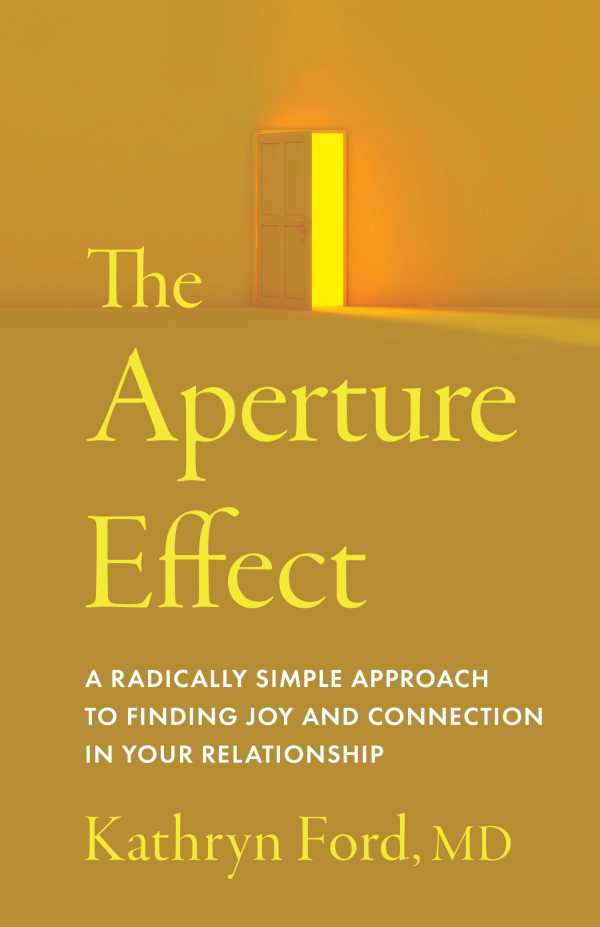
The Aperture Effect
A Radically Simple Approach to Finding Joy and Connection in Your Relationship
Guiding partners to assess and maintain a mutual sense of openness, The Aperture Effect is a supportive relationship guide.
Psychiatrist and couples therapist Kathryn Ford’s relationship guide The Aperture Effect utilizes techniques based on neuroscience, psychology, and mindful thinking to improve relationship synergy and communication between partners.
The book’s central theme is what Ford calls “aperture awareness,” with relationship partners needing to assess and maintain a mutual sense of openness, or aperture level. In developing this approach, Ford applied formal psychiatric training as well as personal studies of Buddhism, yoga, and meditation. The concept of neuroplasticity, or the human brain’s continued experiential ability to adapt, also factors in.
Aperture levels are explained with engaging clarity and range from one to ten in terms of openness. Building upon aperture awareness, the book’s other core practices include dialogue between partners, mindfulness, and focused learning. When positive apertures are established, the book suggests, beneficial dialogue can begin. Mindful perception increases holistic awareness and allows detachment from strong emotions, it claims, while shared learning can provide new revelations and approaches to longstanding problems.
The book includes various partnered exercises to track and increase aperture awareness; while the exercises often involve exploratory and intense conversations, they require only a “comfortable, private place to talk, two notebooks, two pens or pencils, and a timer.” In this regard, the book avoids technology dependence or interference by offering a simplified approach to practicing aperture consciousness. Without minimizing salient information, helpful text boxes summarize key chapter points, while a color-coded “zone” range enhances numerical aperture measurements (green is “calm” and “relaxed,” orange is “less than mindful,” while red requires immediate disengagement to “avoid harmful interactions”).
In delving further into partner dialogue and individual and shared behaviors, the book includes case studies that highlight the expectations, irritations, stressors, and resentments that many couples experience. Beyond neuroplasticity, other scientific concepts like behavioral links to dopamine levels and empathy-inducing “mirror neurons” are explained in coherent terms. A variety of references broaden the text, from a humorous romantic disagreement in Woody Allen’s Annie Hall to the biblical wisdom of Ephesians 4:26, or “Let not the sun set on your anger.”
Though the book is recommended as a resource for both couples and therapists, in situations where one party tends toward evasiveness or the domination of a relationship, it would seem that a therapist’s neutral guidance would be preferable to partners working on their own. This is suggested as the preferred option for what the book refers to as “major damage,” or salvaging a relationship troubled by affairs or substance abuse. But with these more serious issues, the evolved expression of anger becomes somewhat ambiguous and could be misconstrued or manipulated by the “offender” to lessen culpability; though anger is acknowledged as suffering for which “we deserve compassion, from our selves and our partner,” this differs from the “all-too common assumption, often less than conscious, that for anger we deserve the perks of being a victim, including that the other person is to blame and should be punished.”
Ford notes that the book does not “talk directly about sex,” even though physical intimacy is an integral part of many relationships. Rather than seeming like an avoidance, this refocus allows for a sustained emphasis on communication and collective growth, and it is supplemented by a brief appendix of resources regarding couples’ sexuality.
Balancing neurological research with emotional potential, The Aperture Effect is an immersive and accessible relationship guide.
Reviewed by
Meg Nola
Disclosure: This article is not an endorsement, but a review. The publisher of this book provided free copies of the book and paid a small fee to have their book reviewed by a professional reviewer. Foreword Reviews and Clarion Reviews make no guarantee that the publisher will receive a positive review. Foreword Magazine, Inc. is disclosing this in accordance with the Federal Trade Commission’s 16 CFR, Part 255.
